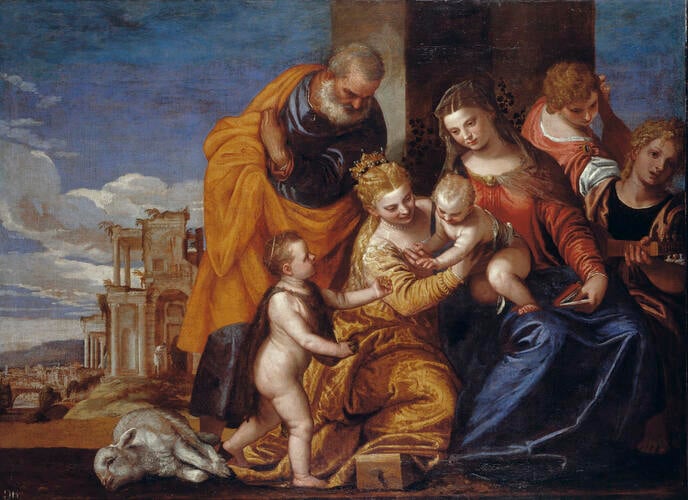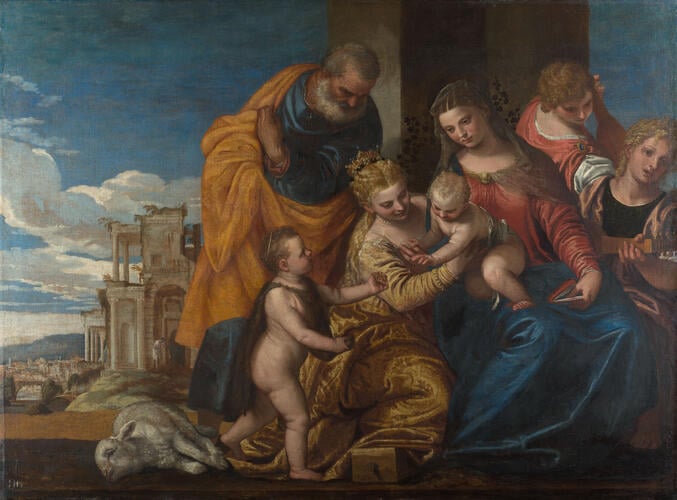-
1 of 253523 objects
The Mystic Marriage of St Catherine of Alexandria c.1562-9
Oil on canvas | 148.0 x 199.5 cm (support, canvas/panel/stretcher external) | RCIN 407216
-
Before her martyrdom, Catherine of Alexandria was mystically married to Christ, symbolising the pious soul’s spiritual betrothal to God. With one hand the Christ Child takes the ring from the young John the Baptist, with the other he takes Catherine’s hand to receive it.
This painting depicts Catherine of Alexandria, who before her martyrdom was mystically married to Christ by the Virgin Mary, a ceremony seen as an allegory of the pious soul’s spiritual betrothal to God. Here she is richly dressed and crowned (the Golden Legend records that she was of royal birth) and kneels on part of the broken wheel on which she was to have been executed. With one hand the Christ Child takes the ring from the young John the Baptist, unique in Veronese’s depictions of this subject, and with his other he takes Catherine’s hand to receive it.
The early historian of Venetian art Carlo Ridolfi (1594-1658) was especially enthusiastic about this painting. When he described it as one of the most admired works by the artist the painting had already been sent from Venice to Jan Reynst’s house in Amsterdam. But by the nineteenth century the attribution was doubted. Although some recent critics have accepted it as by Veronese, the prevailing opinion is that his brother, Benedetto Caliari (1538-98) contributed to its execution: the compact, solid figures and heavier modelling of folds are more typical of his style.
This painting dates from a period when Veronese became more aware of the heritage of classical antiquity and the High Renaissance. In 1560 he visited Rome (with Girolamo Grimani, Procurator of San Marco), where he must have studied Raphael, Michelangelo and antique art. In 1561 he provided fresco decoration for the Villa Maser, built for Daniele Barbaro, the humanist and translator of Vitruvius, and designed by Andrea Palladio, the most classically erudite architect of the period. This painting also shows the impact of these classical influences. There is a grandeur in this scene, the figures are clearly organised on an imposing stage, and given dignity by our low viewpoint. Other commissions of this period show Veronese using figures and architecture in a similar way, for example Feast in the House of Simon (c.1560; Galleria Sabauda, Turin). The landscape showing a city like Verona by a river framed by a ruined building, has been compared with the similar landscapes by the artist in the Villa Barbaro at Maser (where Veronese’s brother Benedetto certainly contributed substantially to the work).
The ruined building recalls the Septizonium that also appears in the Stanza del Tribunale d’Amore in the Villa Barbaro. This was the three-storey ornamental façade and nymphaeum in Rome dedicated to Septimus Severus in ad 203, which was fortified in about ad 1000, but gradually deteriorated until it was demolished in 1588-9. Despite his recent Roman visit, Veronese seems to have copied the antique buildings at Maser both from the famous set of prints made by Hieronymus Cock and copies of his prints by Battista Pittoni. The classical building in this painting is not an exact quotation from Cock and must derive from another source, such as a Pittoni etching (Uffizi) which almost exactly replicates the building in reverse. A similar ruined building derived from a Cock print fills the background of Veronese’s Supper at Emmaus (Louvre), usually dated to the same period.
There is an unusually intimate relationship between the figures in this painting, an idea which Veronese explored in a series of studies covering a single sheet dated c.1568-9, now in the Museum Boymans-Van Beuningen Museum, Rotterdam. Other paintings by Veronese and his workshop have been related to these sketched ideas: his Holy Family with Sts Barbara (or St Catherine) and John the Baptist of c.1562-5 (Uffizi) and Mystic Marriage of St Catherine (versions in Musée des Beaux-Arts, Brussels, the Timken Art Gallery, San Diego and the Musée Fabre, Montpelier). John Shearman suggested that Veronese had developed the unusual idea of St John holding up the ring from a engraving by Giorgio Ghisi, dated to the mid-1550s, which was based on a composition by Francesco Primaticcio. Veronese may have been inspired by the print, but he and his workshop must have been producing variations on this theme in the 1560s. The figure of John in a similar tunic intervening in the group is closest to his counterpart in the San Diego painting, produced by Veronese’s workshop and recorded in an engraving, while the landscape setting has the splendour of the lost world of antiquity also captured in the pastoral landscapes of the Villa Maser.
The painting appears in Pyne's illustrated 'Royal Residences' of 1819, hanging in the Crimson Drawing Room at Buckingham Palace (RCIN 922142).
Catalogue entry adapted from The Art of Italy in the Royal Collection: Renaissance and Baroque, London, 2007Provenance
Sent from Venice to Amsterdam by Jan Reynst; acquired from the collection of his brother Gerard Reynst by States of Holland & West Friesland and presented to Charles II, Nov 1660; listed in the Square Table Room at Whitehall in 1666 (no 165)
-
Creator(s)
Acquirer(s)
-
Medium and techniques
Oil on canvas
Measurements
148.0 x 199.5 cm (support, canvas/panel/stretcher external)
128.3 x 195.0 cm (support (etc), excluding additions)
178.0 x 230.1 x 12.0 cm (frame, external)
Category
Object type(s)
Other number(s)
Alternative title(s)
Marriage of St. Catherine

